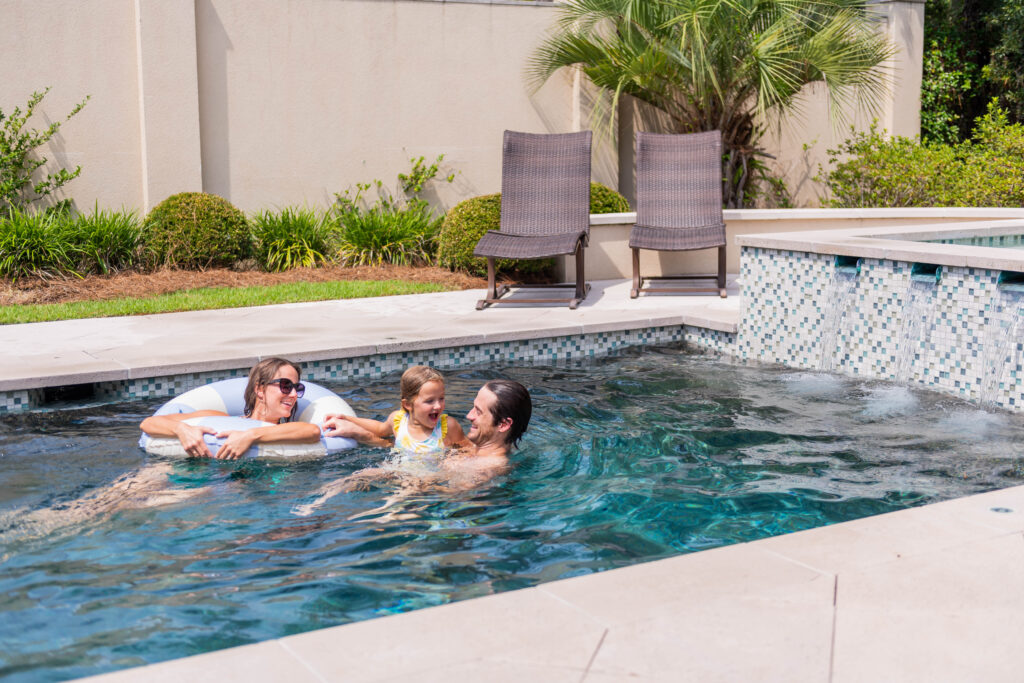
Teaching your child to swim is an exciting opportunity to bond and enjoy your pool time together! For coastal South Carolina residents especially, swimming is an essential life skill and can instill confidence, improve health and provide peace and joy throughout our lives. This guide will help ensure safe family fun in your Aqua Blue pool.
Why Teach Your Child to Swim?
More than good, healthy fun, swimming is a life-saving skill for all ages. This is especially true for children who, according to the American Academy of Pediatrics (AAP) face drowning as a leading cause of death. Formal swim lessons reduce this risk by 88% for children as young as one year old.
Aside from safety concerns, teaching your child how to swim can also offer mental, physical and social development. Swimming is a fantastic exercise that promotes heart health, improves strength and flexibility, enhances stamina and can contribute to maintaining a healthy weight.
The step-by-step process of learning to swim can also significantly boost a child’s self-esteem as they master new skills. Achieving these milestones not only increases their confidence in the water but also in other areas of their lives.
And, of course, swimming is just plain fun! It opens up a world of activities, from beach vacations to pool parties, and can even help children develop interpersonal skills such as teamwork and cooperation through swim lessons, sports and play dates with friends.
Tips for Teaching Your Child to Swim
Remember, the goal is not just to teach swimming but to foster a love for the water that can provide health and pleasure for a lifetime. By following these tips in support of your child’s swim lessons, you can help ensure they learn to swim in a safe, enjoyable and supportive environment.
As with all water activities, it is important for parents to seek the advice of experts to ensure proper training and safety. This blog should act as a supplementary guide for the lessons of trained and certified swim instructors.
1. Introduce your child to the fun of water early.
Introducing your child to water at a young age can help them become comfortable and reduce fear. Babies can be introduced to water through supervised bath time play, which is a gentle way to start. AAP recommends children begin formal lessons after their first birthday. This early exposure sets the foundation for proper swimming techniques later on.
2. Gather the proper equipment.
Equip your child with the appropriate swim gear. This includes swimwear that fits well, goggles to protect their eyes from chlorine and a life vest and other flotation devices. Proper gear can make swimming easier and more comfortable for your child.
3. Prioritize your child’s safety.
Always prioritize safety. Never leave your child unattended in or near water, even if they can swim. Use appropriate floatation devices, but do not rely on them to keep your child safe. Ensure that every swimming session occurs while an adult is actively watching, ready to assist if necessary.
4. Foster a positive learning environment.
Children learn best when they are having fun. Keep the mood light and positive. Use games, songs and playful activities to teach skills. Praise their efforts, celebrate their progress and always maintain a supportive tone.
5. Take lessons slow and steady.
Start with basics like blowing bubbles, learning to kick and floating before moving on to more complex skills like strokes. Each child learns at their own pace, so it’s important to be patient and not rush the process. Ensure each skill is mastered before moving on to the next to build a strong foundation for what’s to come.
6. Practice makes perfect.
Like all skills, consistency is key in learning how to swim. Regular practice helps reinforce skills and improve comfort in the water. Even if you can’t get to a pool, practicing movements on dry land can also be beneficial. Join your child in practicing techniques to show them how it’s done and motivate their participation.
7. Address fear and concerns openly and calmly.
It’s normal for children to feel apprehensive about water. Address fears by understanding what your child is anxious about and offering reassurance. Never force a child into the water, as it can increase fear. Instead, gradually acclimate them to the water’s feel, starting at the shallow end of the pool.
8. Use the buddy system.
Teach your child the importance of the buddy system. Swimming with a friend under adult supervision can be safer and more fun. It teaches children to look out for one another and can make swimming a more social experience.
9. Do your research before choosing a swim Instructor.
When selecting a swim instructor or swim school, look for certified professionals with experience teaching children. A good instructor will not only teach swimming skills but will also make the learning process fun and engaging for your child. Check the instructor’s qualifications and ensure they are trained in CPR and water safety.
Create a Space For New Family Memories
As the Lowcountry’s premier custom pool builder, Aqua Blue Pools is ready to bring your dream pool to life. Since 1991, our team has designed and built pools in a range of styles for residential and commercial clients from South Carolina’s Lowcountry to Savannah. We are proud to work closely with our clients to create and execute impressive custom projects built to last. Contact us today to begin planning your oasis!


